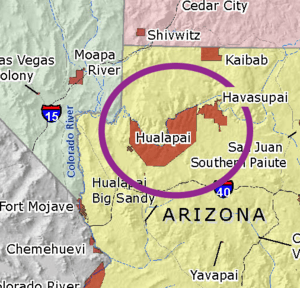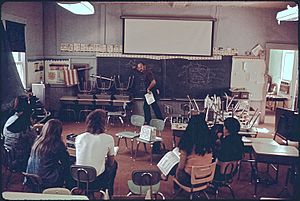Havasupai–Hualapai language facts for kids
Quick facts for kids Havasupai–Hualapai |
||
|---|---|---|
| Havasupai Upland Yuman |
||
| Region | Arizona, United States | |
| Ethnicity | 570 Havasupai, 1,870 Walapai (2007) | |
| Native speakers | Hualapai: about 1,000, all ages (2015 census)e18 Over 500 Havasupai, all ages (2007) |
|
| Language family |
Yuman–Cochimí
|
|
| Dialects |
Havasupai
Hualapai
|
|
| Writing system | Latin | |

The Hualapai and Havasupai reservations are circled on this map in purple, where most speakers of the language live.
|
||
| Template:Infobox language/ipa
|
||
Havasupai–Hualapai (Havasupai–Walapai) is the Native American language spoken by the Hualapai and Havasupai peoples of northwestern Arizona. Havasupai–Hualapai belongs to the Pai branch of the Yuman–Cochimí language family, together with its close relative Yavapai and with Paipai, a language spoken in northern Baja California. There are two main dialects of this language: the Havasupai dialect is spoken in the bottom of the Grand Canyon, while the Hualapai dialect is spoken along the southern rim. As of 2010, there were approximately 1500 speakers of Havasupai-Hualapai. UNESCO classifies the Havasupai dialect as endangered and the Hualapai dialect as vulnerable. There are efforts at preserving both dialects through bilingual education programs.
Contents
Regional variation and mutual intelligibility
The modern Hualapai and Havasupai have separate sociopolitical identities, but a consensus among linguists is that the differences in speech among them lie only at the dialect level, rather than constituting separate languages (Campbell 1997:127; Goddard 1996:7; Kendall 1983:5–7; Mithun 1999:577–578), and the differences between the two dialects have been reported as "negligible" (Kozlowski 1976:140).
The language even bears similarity to Yavapai, and sometimes they are grouped together for means of linguistic classification (see Ethnologue). Regarding the relationship of Havasupai and Hualapai to Yavapai, Warren Gazzam, a Tolkapaya Yavapai speaker, reported that "they (Hualapais) speak the same language as we do, some words or accents are a little different".
Phonology
Consonants
For illustrative purposes, the following chart is the consonant inventory of the Hualapai dialect of the language, which varies slightly from the Havasupai dialect. Because the two dialects have different orthographies, IPA symbols are used here. For more information about how these sounds are depicted in writing, see the Orthography section of this page.
| Bilabial | Labio- dental |
Dental | Alveolar | Palatal | Velar | Uvular | Glottal | ||||
|---|---|---|---|---|---|---|---|---|---|---|---|
| plain | lab. | plain | lab. | ||||||||
| Nasal | m | n | ɲ | ŋ | |||||||
| Plosive/ Affricate |
plain | p | t̪ | t | t͡ʃ | k | kʷ | q | qʷ | ʔ | |
| aspirated | pʰ | [[Error using : IPA symbol "t̪ʰ" not found in list|t̪ʰ]] | tʰ | t͡ʃʰ | kʰ | ||||||
| Fricative | β | f, v | θ | s | h | ||||||
| Flap | ɾ | ||||||||||
| Approximant | w | l | j | ||||||||
As shown from the chart above, aspiration is a contrastive feature in many stops and affricates in Hualapai-Havasupai. Often, consonant sounds are realized in different ways in different phonetic environments. For example, if a glottal stop occurs at the beginning of a word, it may sometimes be replaced by a vowel such as /a/.
The phonemic difference between /β/ and /v/ is widely discussed in the literature. Watahomigie et al. poses that the use of /β/ is attributed to older generations of Hualapai dialect speakers, and Edwin Kozlowski notes that in the Hualapai dialect, [v] is weakened to [β] in weak-stressed syllables. Thus, the underlying form /v-ul/ "to ride" surfaces as [βəʔul].
Long and short vowels are contrastive in the language. The following is a minimal pair illustrating of the phonemic contrast of Havasupai-Hualapai vowel length: 'pa:ʔ' (meaning person) vs. 'paʔ' (meaning arrow).
| Front | Central | Back | |
|---|---|---|---|
| Close | i iː | u uː | |
| Mid | e eː | o oː | |
| Open | æ æː | a aː |
Short vowels may sometimes be reduced to [ə] or dropped completely when they occur in an unstressed syllable, primarily in a word-initial context. In addition to this chart, there are four attested diphthongs that are common for this language: /aʊ/ as in 'cow', /aɪ/ as in 'lie', /eɪ/ as in 'they', and /ui/ as in 'buoy'.
Stress
Havasupai-Hualapai's prosodic system is stress-timed, which governs many parts of the phonological structure of the language, including where long vowels occur, what kind of consonant clusters can occur and where, and how syllable boundaries are divided. There are three types of stress: primary, secondary, and weak. All vowels can have any of these three types of stress, but syllabic consonants can only have weak stress. Primary stresses occur at regularly timed intervals in an utterance. Secondary stresses occur according to an alternating-stress system, which most commonly dictates that two secondary stresses follow a primary stressed (phonetically long) vowel.
Syllabic structure
The most common syllable structures that occur in Havasupai-Hualapai are CV, CVC, and VC; however, consonant clusters of two or three consonants can and do occur initially, medially, and finally.
At word boundaries, syllabification breaks up consonant clusters to CVC or CV structure as much as is possible. CCC and CCCC clusters occur, but they are always broken up by a syllable boundary (that is, C-CC/CC-C or CC-CC). Syllable-initial CC clusters are either composed of (1) /θ/, /s/, or /h/, followed by any consonant or (2) any consonant followed by /w/.
Morphology
Morphologically, Hualapai-Havasupai is classified by WALS as weakly suffixing. There are different affixes for nouns, verbs, and particles in Hualapai-Havasupai, and there exist suffixes that can change nouns to verbs and vice versa. The affixes that exist—apart from word roots—are generally short in phonemic length, restricted to C, CV, VC, or V in composition.
Verbs
Verbs are marked for person (first, second, and third) through the prefixes /a-/, /ma-/, and /ø-/, respectively. Many other affixes attach to the verb to reveal information like tense, aspect, modality, number, adverbial qualities, and conjunctivity. The verb suffixes /-wi/ and /-yu/ are divisive for verbs and are weak-stressed by-forms of /wí/, meaning do, and /yú/, meaning be. These occur on all verbs. The three numbers that can be marked in verbs are singular, paucal plural, and multiple plural. There are six types of aspect, and any verb can have as many as three and as few as zero aspect markers. The six types are distributive-iterative, continued, interrupted, perfective, imperfective, and habitual.
Nouns
Nouns are marked for number, case, definiteness, and demonstrativeness, as can be seen by the lists of noun suffixes and prefixes below:
- Noun prefixes
- Subordinate: /-ɲi/ 'subordinate to, related to'
- Intensive: /vi-/ 'very, just'
- Noun suffixes
- Number: /-t͡ʃ/ paucal plural, /-uv/ multiple plural, no affix for singular number
- Demonstrative: /-ɲ/ that, /-v/ this
- Definiteness: /-a/ the (a certain), /-i/ the (this other), /-u/ the (that other), /-o/, the former (that)
- Case: /-t͡ʃ/ nominative, /-ø/ accusative, /-k/ allative-adessive, /-l/ illative-inessive, /-m/ ablative-abessive
- Appellative: /-é/ vocative
Particles
Particles exist as interjections, adverbs, possessive pronouns, and articles. There are relatively few particles that exist in the language. They can be marked through prefixes for subordination and intensity in the same way as nouns and through the suffix /-é/, which indicates adverbial place.
Syntax
Word order
Havasupai-Hualapai's basic word order is S-O-V. For noun phrases, articles, such as demonstratives, occur as suffixes.
Case marking
Havasupai-Hualapai has a nominative/accusative case marking system, as mentioned in the morphology section.
Noun incorporation
It is said that noun incorporation occurs in the language. This is notable with verbs of belonging, such as with the noun "nyigwáy(ya)," meaning "shirt." To say "to be wearing a shirt" the noun form "nyigwáy" is incorporated into the verb, appearing with a prefix for person, and suffixes for reflexiveness and auxiliaries. The noun form obligatorily also occurs before its incorporated verb form:
nyigwáy
shirt
'-nyiggwa:y(-v)-wi
3/1-shirt(-REFL)-AUX
"I have a shirt on."
Similar processes occur with kinship terms and verbs of belonging such as with the following noun "bi:", which means "female's brother's child/nephew/niece":
e'e
yes
'-bi:-v-wi
3/1-nephew-REFL-AUX
"Yes, I have a nephew/niece."
This can be considered a more iconic form of noun incorporation, as the noun doesn't also occur outside the incorporate verb form.
Orthography
Havasupai and Hualapai have developed separate orthographies in order to distinguish the two tribes socially and culturally. Hualapai's orthography was developed in the 1970s partly as an effort to preserve the language for pedagogical and historical purposes. Both of the orthographies are adapted from the Latin Script.
| a | ae | b | ch | d | đ | e | f | g | h | i | k | l | m | n |
| ny | ng | o | p | q | s | t | th | ŧ | u | v | w | y | ’ |
Havasupai dialect
This dialect is spoken by approximately 639 people on the Havasupai Indian Reservation at the bottom of the Grand Canyon. According to a 2015 New York Times article, it was considered the only Native American language in the United States spoken by 100% of its tribal members. Also as of 2005, Havasupai remained the first language of residents of Supai Village, the tribal government seat.
The Lord's Prayer, John 3:16, and hymns were printed in Havasupai in 1934.
As of 2004, "a Wycliffe Bible Translators project ... under way to translate the Old and the New Testaments into the Havasupai language" was progressing slowly.


